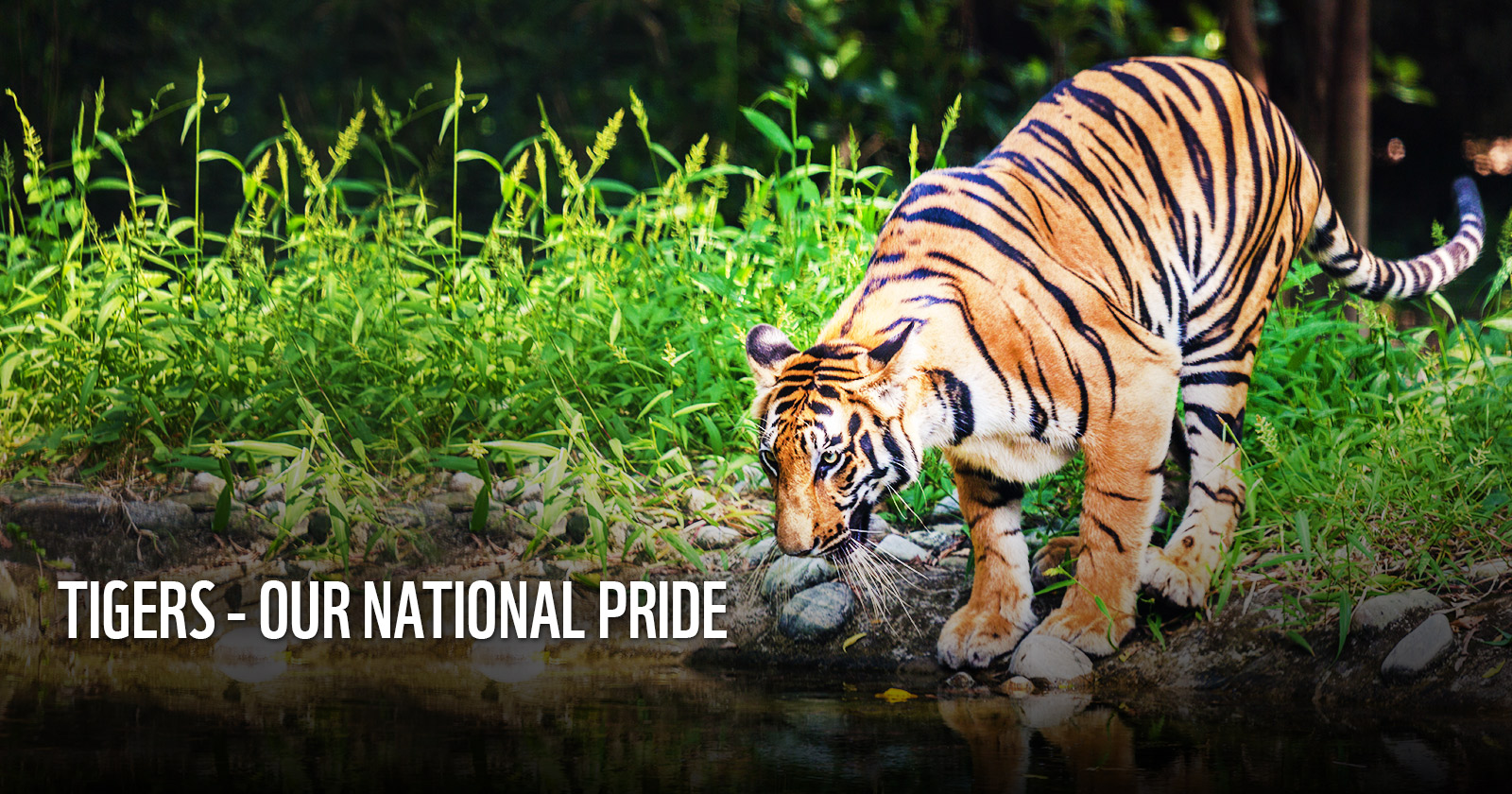TIGERS FOR A HEALTHY TOMORROW
Presence of tigers indicates that an ecosystem, such as a forest is healthy. We often don’t realize but our lives are dependent on the various ecosystem services such as clean air, freshwater, and a multitude of other natural resources that we need for survival.
Tigers are constantly under threat – poaching, illegal wildlife trade, habitat loss and fragmentation, and conflict are some activities that makes it extremely difficult for this big cat to survive. These endangered big cats need our help in their protection.
If tigers go extinct, the entire ecosystem would collapse.
YES, I WOULD LIKE TO PROTECT TIGERS
WWF INDIA'S TIGER CONSERVATION INITIATIVES
India is home to the magnificent Royal Bengal tiger and thus, it is our responsibility to protect it. Of the approximate 3,900 wild tigers in the world, 70% of them reside in our country. WWF India's association with tiger conservation goes back to the early 1970s when it played an instrumental role in implementing 'Project Tiger' – the first-ever tiger conservation programme - launched by the Government of India in 1973. With an aim to stabilize the declining tiger population in the country, WWF India initiated a focused Tiger Conservation Programme (TCP) in the 1990s. WWF was the largest non-government partner in the NTCA and the Wildlife Institute of India (WII) led all India tiger population estimation exercises in 2018.
WWF India's tiger conservation work includes:
Research, monitoring & spatial planning
WWF India along with state forest departments and National Tiger Conservation Authority (NTCA) conducts extensive monitoring in all its tiger landscapes to estimate population size, trends, and other demographics for tigers, co-predators and prey. WWF's monitoring revealed the presence of tiger populations beyond protected areas and several tracts of tiger habitats have since been notified as protected areas. Camera trappings help trace movement of dispersing tigers that further helps in identifying existing/potential corridors that are in need of protection or restoration, facilitating the rehabilitation of tigers and understanding tiger occurrences in human-dominated areas. Spatial planning tools help demonstrate integrated land use planning and future development pathways that consider the economic aspirations of communities and governments while maintaining biodiversity.
Securing corridors
WWF India works in critical tiger corridors connecting 21 Protected Areas across India. Some of these corridors are Chilla - Motichur, Nihal Bakhra, Kosi river and Kilpura Khatima Surai in Terai Arc Landscape, Kanchanjuri and Haldibari in Assam landscape, Kanha - Pench and Kanha - Achanakmar in Satpura Maikal landscape, Segur in Western Ghat - Nilgiris landscape and Ranthambhore – Keladevi – Kuno and Ranthambhore – Mukundra in Western India Tiger landscape. Corridor conservation initiatives of WWF India include studying connectivity modeling, detailed surveys to inform land use planning, development of corridor management plans, addressing human-wildlife conflict in corridors and sustained engagement with multiple government agencies to mitigate impacts of existing and planned linear development.
Mitigating human-tiger conflict
WWF India works closely with local communities living around tiger habitats to mitigate human tiger conflict issues. Immediate financial support under the Interim Relief Scheme (IRS) is provided as an interim relief to victims in case of loss of cattle and ex-gratia payment in case of human injury or death. This interim relief helps appease sudden anger and controls retaliatory killing of tigers by the local communities who have suffered losses. Long-term human-wildlife conflict management measures are taken by setting up of trenches around agricultural fields to reduce crop damage by wild herbivores, and installation of solar lights in the periphery of villages to deter tigers from moving into human settlements.
Supporting & strengthening protection
WWF India provides strategic and timely infrastructural support to State Forest Departments to increase efficacy of protection measures by supplying patrolling vehicles, field clothing such as jackets, boots and flashlights, metal detectors, GPS units, walkie-talkies, training sniffer dogs, construction of anti-poaching camps and wireless towers, facilitating meetings between protection agencies of different countries to facilitate improved transboundary efforts to combat poaching, and implementing modern technology aided patrolling systems. Need based logistical support to Forest Department are also provided for strengthening protection during floods and other emergency situation. WWF India emphasizes on strengthening protection in Reserve Forests and other tiger habitats outside of Protected Areas.
Working with local communities
With the passing of the Forest Rights Act, forest dwelling and indigenous communities have rights over land and resources. The success of conservation measures is upon active engagement of local communities living around Tiger Reserves. WWF India has a comprehensive program to promote sustainable development, encourage involvement of locals and help reduce forest dependence. Alternate livelihood options are introduced such as production of jute/paper bags, vermi-composting, carpet weaving, mushroom and honey cultivation, and animal husbandry, which reduces their dependence on venturing into forests. Smokeless stoves are provided to villagers and they are encouraged to use biogas and bio-briquettes. They are informed about different government programmes for livelihood development.
Support through TRAFFIC India
WWF India also works with partners such as TRAFFIC India and Wildlife Crime Control Bureau to detect and curb illegal wildlife trade. TRAFFIC is a joint programme of WWF and IUCN. In India, it operates as a division of WWF India with an aim to monitor and investigate wildlife trade, and provide information to stakeholders as a basis for effective conservation policies.The organization also conducts regular capacity building workshops for enforcement agencies on wildlife monitoring, wildlife law, anti-poaching, illegal wildlife trade and use of advance technology to combat poaching. Enforcement agencies are also provided training on wildlife law and crime prevention.
Research, monitoring & spatial planning
WWF India along with state forest departments and National Tiger Conservation Authority (NTCA) conducts extensive monitoring in all its tiger landscapes to estimate population size, trends, and other demographics for tigers, co-predators and prey. WWF's monitoring revealed the presence of tiger populations beyond protected areas and several tracts of tiger habitats have since been notified as protected areas. Camera trappings help trace movement of dispersing tigers that further helps in identifying existing/potential corridors that are in need of protection or restoration, facilitating the rehabilitation of tigers and understanding tiger occurrences in human-dominated areas. Spatial planning tools help demonstrate integrated land use planning and future development pathways that consider the economic aspirations of communities and governments while maintaining biodiversity.
Securing corridors
WWF India works in critical tiger corridors connecting 21 Protected Areas across India. Some of these corridors are Chilla - Motichur, Nihal Bakhra, Kosi river and Kilpura Khatima Surai in Terai Arc Landscape, Kanchanjuri and Haldibari in Assam landscape, Kanha - Pench and Kanha - Achanakmar in Satpura Maikal landscape, Segur in Western Ghat - Nilgiris landscape and Ranthambhore – Keladevi – Kuno and Ranthambhore – Mukundra in Western India Tiger landscape. Corridor conservation initiatives of WWF India include studying connectivity modeling, detailed surveys to inform land use planning, development of corridor management plans, addressing human-wildlife conflict in corridors and sustained engagement with multiple government agencies to mitigate impacts of existing and planned linear development.
Mitigating human-tiger conflict
WWF India works closely with local communities living around tiger habitats to mitigate human tiger conflict issues. Immediate financial support under the Interim Relief Scheme (IRS) is provided as an interim relief to victims in case of loss of cattle and ex-gratia payment in case of human injury or death. This interim relief helps appease sudden anger and controls retaliatory killing of tigers by the local communities who have suffered losses. Long-term human-wildlife conflict management measures are taken by setting up of trenches around agricultural fields to reduce crop damage by wild herbivores, and installation of solar lights in the periphery of villages to deter tigers from moving into human settlements.
Supporting & strengthening protection
WWF India provides strategic and timely infrastructural support to State Forest Departments to increase efficacy of protection measures by supplying patrolling vehicles, field clothing such as jackets, boots and flashlights, metal detectors, GPS units, walkie-talkies, training sniffer dogs, construction of anti-poaching camps and wireless towers, facilitating meetings between protection agencies of different countries to facilitate improved transboundary efforts to combat poaching, and implementing modern technology aided patrolling systems. Need based logistical support to Forest Department are also provided for strengthening protection during floods and other emergency situation. WWF India emphasizes on strengthening protection in Reserve Forests and other tiger habitats outside of Protected Areas.
Working with local communities
With the passing of the Forest Rights Act, forest dwelling and indigenous communities have rights over land and resources. The success of conservation measures is upon active engagement of local communities living around Tiger Reserves. WWF India has a comprehensive program to promote sustainable development, encourage involvement of locals and help reduce forest dependence. Alternate livelihood options are introduced such as production of jute/paper bags, vermi-composting, carpet weaving, mushroom and honey cultivation, and animal husbandry, which reduces their dependence on venturing into forests. Smokeless stoves are provided to villagers and they are encouraged to use biogas and bio-briquettes. They are informed about different government programmes for livelihood development.
Support through TRAFFIC India
WWF India also works with partners such as TRAFFIC India and Wildlife Crime Control Bureau to detect and curb illegal wildlife trade. TRAFFIC is a joint programme of WWF and IUCN. In India, it operates as a division of WWF India with an aim to monitor and investigate wildlife trade, and provide information to stakeholders as a basis for effective conservation policies.The organization also conducts regular capacity building workshops for enforcement agencies on wildlife monitoring, wildlife law, anti-poaching, illegal wildlife trade and use of advance technology to combat poaching. Enforcement agencies are also provided training on wildlife law and crime prevention.
Your support today can help strengthen our efforts to protect and conserve the magnificent the Royal Bengal tiger.



